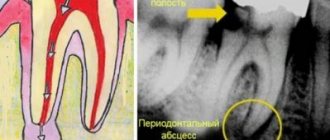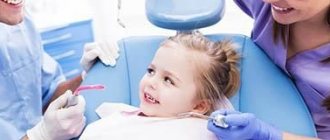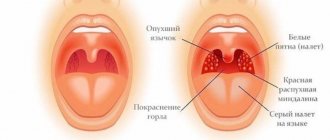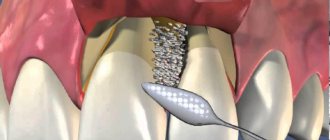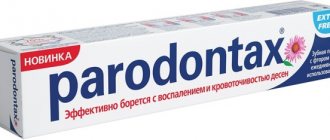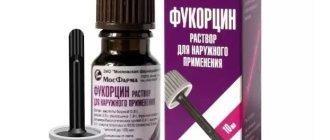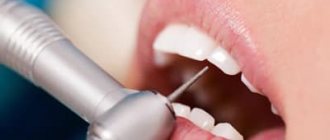Sometimes situations arise when the threads used to stitch wounds have to be removed independently. In the “Instructions” section we will tell you how to remove sutures at home without problems, pain and complications, and in which cases it is better to consult a specialist.
The need for suturing in dentistry
Surgical intervention and, as a consequence, suturing are indicated for the following manipulations:
- Removal of wisdom teeth - third molars differ from the rest in the large size of the tooth crown and its root. Late eruption, the position of the “extreme” in the dentition very often leads to a violation of the physiological location of the tooth or even its impaction (partial or complete failure to erupt). In this regard, the procedure for removing a wisdom tooth is often accompanied by complications - extensive damage to the soft tissues of the oral cavity and alveolar process, ligaments, and blood vessels. To avoid this kind of consequences, dentists apply stitches to reduce the wound.
- Implantation - its implementation is always accompanied by the need for surgical intervention. A deep incision in the gum requires suturing.
- Maxillofacial operations - elimination of the consequences of traumatic injuries, congenital defects of the dentofacial apparatus.
- Removal of tumors of various etiologies - the integrity of the soft tissues of the oral cavity is damaged, often requiring layer-by-layer sutures.
The main types of treatment for atheroma without surgery
Atheroma is a benign tumor formed as a result of blockage of the sebaceous glands.
Atheroma forms mainly on the neck, face, groin area and back. The neoplasm is considered relatively safe, since it has no tendency to degenerate into cancer. Below we will tell you whether it is possible to remove atheroma of the scalp with a laser? and “is it possible for the tumor to re-form, as well as what earlobe atheroma and other forms of the disease look like. Causes of the disease:
- improper skin care;
- injuries, skin cuts;
- excessive use of deodorants;
- hormonal disorders;
- hypersweating (hyperhidrosis);
- pimples, blackheads;
- inflammation of the epidermis;
- metabolic disease.
The main method of treating pathology is surgery. Below we will talk about the types of treatment for atheroma without surgery.
Types of sutures and materials used in dentistry
To facilitate and accelerate the healing process of postoperative wounds in the oral cavity, the following types of sutures are used:
- nodal - used when it is important to ensure equal tension on both edges of the wound (for example, between teeth);
- continuous - when a violation of the integrity of soft tissue occurs along several dental units;
- single - each stitch is knitted separately from each other.
Threads used for suturing in dentistry can be made of absorbable and non-absorbable material.
Absorbable threads:
- from catgut - which contains a foreign protein, which is perceived by the body as a foreign body, and therefore often causes inflammation of the damaged soft tissue of the patient’s oral cavity;
- “Vicryl” is a synthetic material made from polyclatin and polyglycomic acid, which does not cause the risk of developing inflammatory processes even during complex operations.
Threads made of absorbable material do not require the removal of sutures; they disappear within 2-5 weeks.
Material for non-absorbable threads:
- silk is an easy-to-use material, highly durable, but has a significant drawback - it causes inflammatory processes in soft tissues if not removed 7 to 10 days after surgery;
- monofilament is a thread made of polytetrafluoroethylene, which is durable and does not cause inflammation, but has a rigid structure that can damage the mucous membrane. To exclude this possibility, a bandage is applied to the wound surface;
- polyester is a woven thread often coated with silicone for elasticity and smoothness. A very durable material that does not lead to inflammatory processes, but requires careful fixation in the form of knots.
Precautionary measures
If you feel severe pain or see blood while removing a suture, stop immediately. This means that the wound has not yet healed and it is dangerous to touch it, otherwise the edges will separate. Pain, tissue inflammation, suppuration or increased temperature after removal of the threads are a dangerous sign. It indicates that the tissue has become infected and requires immediate medical attention.
We categorically do not recommend removing stitches at home, especially if you are not confident in your abilities. Contacting specialists Dr. Mos will relieve you of discomfort and unwanted consequences of the procedure.
Author: Ph.D. surgeon Samsonova G.S.
When and how is the procedure for removing sutures in dentistry performed?
The time for suture removal is determined by the dentist, guided by the process of regeneration (healing) of the soft tissues of the mucous membrane, which depends on:
- on the age of the patient;
- complications of surgical intervention;
- presence of complications.
Usually, sutures are removed 5-10 days after they are applied.
The dentist removes sutures as follows:
- the surface of the wound is disinfected with an antiseptic;
- if the patient has a low pain threshold, local anesthetics are used (but usually this is not necessary);
- Using surgical scissors and anatomical tweezers, the dentist carefully cuts and removes the threads from the healed wound;
- a visual examination is carried out to check the integrity of the wound;
- Disinfection of the suture prevents the risk of wound inflammation.
Sometimes sutures are removed due to the risk of suppuration in the area of the operation. In this case, the sutures are removed, sanitizing procedures are performed and appropriate antimicrobial therapy is prescribed.
Atheroma in a child
When examined by a specialist, it is extremely important to distinguish atheroma from lipoma. Atheroma in a child is a smooth, round neoplasm located deep in the skin. When palpated, it is soft and motionless. In most cases, the cyst does not cause any discomfort to the baby. There is no threat to health. When an inflammatory process occurs, the situation is completely different. The main symptoms include: redness of the tumor, pain when pressed, discharge of blood or pus. With such manifestations, urgent medical attention is required.
On our website Dobrobut.com you can make an appointment with a doctor and find out how to treat atheroma of the eyelid in a child. Consultations are conducted by specialists with many years of experience. If necessary, a diagnosis and course of treatment will be prescribed.
Hygienic oral care after suture removal
To quickly restore the integrity of the soft tissue of the oral cavity, the patient must:
- Use a soft toothbrush to brush your teeth daily;
- use anti-inflammatory rinses;
- rinse the mouth with warm water or a decoction of medicinal herbs after each meal;
- Avoid eating hard, sour, salty, spicy foods that can irritate the mucous membrane.
Timely removal of sutures, maintaining oral hygiene, and performing procedures prescribed by the dentist will ensure good wound healing and speed up recovery.
When is it filmed?
The exact period after which the stitches are removed is 10-14 days. At the same time as the threads, the fixing bandage is also removed and the dressing is done again. From now on, the patient can wear the bandage during nighttime sleep, rather than wearing it on an ongoing basis.
But the withdrawal period may vary, since the recovery rate is different for all patients. If threads that can dissolve on their own were used, there is no need to worry about removal. In this case, a visit to the surgeon will only be necessary for a second examination.
After otoplasty, the seams, or more precisely, the scars at the incision sites, are almost invisible. At first, traces of the intervention will be visible, but in the process of tissue restoration, the visibility will gradually disappear.
Lifestyle with sutures on the cervix, vagina and perineum
Cervical ruptures during labor and subsequent suturing of the ruptures do not impose additional restrictions on a woman’s activity, unlike perineal injuries.
If there are tears and seams in the perineal area, the young mother is instructed to strictly follow the following recommendations:
- During the first three weeks after childbirth, sitting positions should be avoided; this period is necessary for the complete fusion of the muscles of the perineum and pelvic floor. It is necessary to perform all usual activities (eating, performing hygiene procedures, personal care), as well as taking care of the newborn while standing or lying down. This also applies to traveling in a car - the back seat must be cleared so that a woman can sit there comfortably and safely. There are special positions to avoid stress on the perineum, “half-sided”, “leg to leg”, the doctor should explain this in detail. An excellent option for active mothers is an orthopedic circle; you can even sit on it while driving.
— Visit the toilet to have timely bowel movements and avoid constipation. The patient is allowed to sit on the toilet on the first day after birth. To facilitate the process of defecation, mother can use suppositories (rectal suppositories) with glycerin and other herbal remedies. These effective and at the same time safe drugs help intestinal function and smooth bowel movements. If necessary, the doctor may prescribe other medications, but it must be remembered that when breastfeeding, the baby also receives these substances.
- Do not lift heavy objects. It is highly not recommended to deal with objects and things weighing more than three kilograms, so if the child is large (4 kg or more), you should ask for help from family and friends until the mother’s condition is completely normalized.
Numbness after dental implantation
For most patients, anesthesia wears off within four to five hours after implant placement. Then oral sensitivity should return. If numbness persists after this period, then you have cause for concern because it may indicate nerve damage. This is only possible when the operation was performed on the lower jaw, because there are no large nerves in the upper jaw.
Other symptoms of mandibular nerve injury are lack of facial skin sensitivity, excessive salivation, and difficulty speaking and eating. Timely diagnosis will help to establish the nature and extent of the damage and manage the treatment with medications rather than surgical methods.
Simultaneous (immediate) implantation
This prosthetic method is a one-stage implantation. In this case, the dentist removes the patient’s damaged tooth and immediately installs an artificial root.
Implantation immediately after tooth extraction is only possible if the bone tissue has sufficient volume to accommodate the implant - for example, if the tooth was damaged or lost in an accident. But tooth loss much more often occurs due to diseases when bone tissue is lost. Therefore, this method is not always available.
Dental implantation is an achievement of modern dentistry that allows you to restore lost teeth and use them for the rest of your life. And if you carefully follow your doctor’s recommendations, your smile will always bring joy to your loved ones!
General Tips
How the suture heals after otoplasty and what kind of scar remains after it is also influenced by the patient’s general attitude towards the recommendations for recovery. Firstly, this concerns sports and physical activity. These things need to be excluded from life during the recovery period. After rehabilitation is completed, you will be able to return to your normal lifestyle.
Cigarettes, salty and spicy foods, and any thermal procedures such as a hot bath, sauna, steam room or steam room also negatively affect the healing rate. At first, it is not advisable to sleep in a position other than on your back. It is advisable to limit exposure to ultraviolet radiation on the operated areas.
It is worth noting that all restrictions are temporary and not lifelong. Therefore, there is no need to worry that the operation will somehow affect your usual everyday comfort. The main thing is to carefully follow all recommendations and observe prohibitions.
